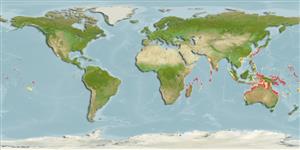>
Anguilliformes (Eels and morays) >
Muraenidae (Moray eels) > Muraeninae
Etymology: Gymnothorax: Greek, gymnos = naked + Greek, thorax, -akos = breast (Ref. 45335); breedeni: Named for Vic. E, Breeden.
Eponymy: Victor Ellis Breeden (1927–1998) was president of the Charline H Breeden Foundation, which gave financial support to the expedition off the Comoros Islands, which collected the moray holotype and studied other Comoran fishes. [...] (Ref. 128868), visit book page.
More on authors: McCosker & Randall.
Environment: milieu / climate zone / depth range / distribution range
Ecologia
marinhas associadas(os) a recifes; intervalo de profundidade 4 - 40 m (Ref. 30874), usually ? - 20 m (Ref. 30404). Tropical
Indo-Pacific: widespread in the Indian Ocean, ranging to some oceanic locations in the Pacific.
Tamanho / Peso / Idade
Maturity: Lm ? range ? - ? cm
Max length : 100.0 cm TL macho/indeterminado; (Ref. 30874)
Vértebras: 128 - 131. Distinctive black patch mark below eye (Ref. 30404). Body brown, speckled darker; dark anus and gill opening (Ref. 3257).
Inhabits clear seaward reefs of oceanic islands to a depth over 25 m (Ref. 9710). Common on reef walls and steep slopes with holes (Ref. 30404). Inhabits porous coral rock which it shares with swarms of anthiases (Ref. 37816). Feeds on fishes and octopi (Ref. 89972). Territorial and will bite when provoked (Ref. 30404). Minimum depth reported taken from Ref. 9710.
Ciclo de vida ou comportamento de acasalamento
Maturidade | Reprodução | Desova | Ovos | Fecundidade | Larvas
Castle, P.H.J. and J.E. McCosker, 1986. Muraenidae. p. 165-176. In M.M. Smith and P.C. Heemstra (eds.) Smiths' sea fishes. Springer-Verlag, Berlin. (Ref. 3257)
Status na Lista Vermelha da UICN (Ref. 130435: Version 2024-2)
Ameaça para os humanos
Traumatogenic (Ref. 30404)
Uso pelos humanos
Pescarias: pouco comercial
Ferramentas
Relatórios especiais
Baixar XML
Fontes da internet
Estimates based on models
Preferred temperature (Ref.
123201): 24.7 - 28.8, mean 27.6 °C (based on 310 cells).
Índice de diversidade filogenética (Ref.
82804): PD
50 = 0.5000 [Uniqueness, from 0.5 = low to 2.0 = high].
Bayesian length-weight: a=0.00048 (0.00025 - 0.00091), b=3.28 (3.12 - 3.44), in cm total length, based on LWR estimates for this Genus-body shape (Ref.
93245).
Nível Trófico (Ref.
69278): 4.5 ±0.80 se; based on food items.
Resiliência (Ref.
120179): Baixo, tempo mínimo de duplicação da população 4,5 - 14 anos (Preliminary K or Fecundity.).
Fishing Vulnerability (Ref.
59153): High vulnerability (60 of 100).
Nutrients (Ref.
124155): Calcium = 27.6 [15.0, 44.0] mg/100g; Iron = 0.466 [0.276, 0.928] mg/100g; Protein = 18.8 [16.6, 21.4] %; Omega3 = 0.104 [0.047, 0.298] g/100g; Selenium = 40.7 [22.0, 81.8] μg/100g; VitaminA = 99.3 [29.0, 315.1] μg/100g; Zinc = 0.759 [0.525, 1.056] mg/100g (wet weight);
